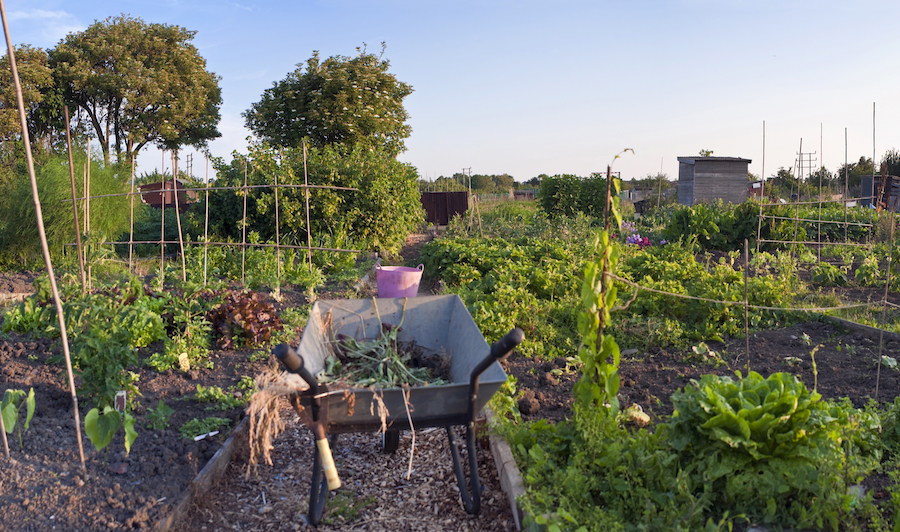How to keep your crops fruiting throughout summer
Veg growing can be endlessly rewarding, but this spring, there was a huge increase in people ripping out their lawns to build veg beds, and adapting their windowsills into mini-greenhouses for the first time.
Lockdown turned many of us into fledgling gardeners, and now those hopeful seeds planted during a crisis, are growing up – and nothing quite beats your first homegrown courgette, or sun-warmed tomato. However, fruiting plants can require more care and attention than you might have anticipated – especially if you’re hoping for crops all summer long.
We caught up with seasoned allotmenter, garden writer and kitchen gardener Rekha Mistry, for her tips for feeding your crops, and increasing the amount of fresh veg you get to pick and eat this summer…
What should budding veg growers know before they start feeding their crops?
“You need to give your crops a good start by nurturing the soil in the previous season, if you can. That’s the best way, so the plants have a good chance of being quite strong and healthy, so that when the feed does come, they can cope with that feed,” explains Mistry.
“Once you plant [your plants] out, keep the beds well weeded and watered – they need to be watered, not to a point where they’re waterlogged, but keep watering so the soil is not dry. And once they get going, I tend to not water too much, let them do what they need to do and keep an eye on them.”
Do you absolutely have to feed plants?
“Yes and no. A lot of people have this idea that ‘no dig’ is the answer to growing without having to do anything to your plot, but it all depends on what nutrients are in the mulch you’ve given your plants. And normally, compost and farm manure does not have the right rich nutrients; they’ve got the bulk the roots can hold on to, but not the feed they need,” says Mistry.
“[Your plants] will need some feed at some point, because once the flowers come on, they need more nutrients to grow bigger and stronger. All the energy is taken up by the fruit, the plant has got nothing left, so they do need that uptake of more nutrients and that’s why they need to be fed.”
Which crops particularly need a feed?
“Your tomatoes, aubergines, peppers, chillies; those are your long season crops, they need the feed, because they’re growing for longer. The minute the flowers come on, the energy’s going there. The more you feed them, the more flowers will come through.”
Which feeds do you recommend?
“I feed flowering plants seaweed and comfrey feed (alternating weekly), and anything that’s not going to flower and will give me greens, like brassicas; nettle feed. I do use [shop-bought] fish, blood and bone by Maxicrop when I can’t get hold of seaweed. Nettles have a lot more nitrogen [good for green growth], whereas comfrey has a lot more potash [good for fruit and flower production].”
How do you make homemade feeds?
“For comfrey, in spring, when the first growth comes through (before it flowers) you collect all the leaves, pack them in a bucket – preferably with a lid, because it smells like no man’s business – put a brick on it to weigh it down, and if you can get rainwater, that’s the best, but just normal tap water will do, fill it up and let that brew in a warm place.

“Leave it outdoors, that’s fine, but in a sheltered place where it will catch the sunlight the majority part of the day, and six weeks later, empty that, dilute it one to 10 parts – one part comfrey tea, nine or 10 parts water – and feed back to your plants. Do the same with the nettles. I make comfrey feed three times in the year, and nettle feed twice a year.”
Why do you make homemade feed?
“It’s free and natural. No chemicals are added, so it’s organic too. [The plants are available] on my allotment and will only die back and get added to the compost bin, so why not make a feed before it gets onto the compost heap?”
When should you start applying feed?
“Plant feed only goes on when the flowers come about. Always wait for the flowers to give them the true feed that they need, at the right dilution.”
How often should you feed plants?
“It’s always once a week. [Crops in pots] need more moisture, but the feed is always once a week – never overdo it with the feed.”
What tricks do you have for increasing pollination (and therefore fruiting)?
“Comfrey again is a very good plant to have, just for the sake of getting pollinators in because it produces so many flowers. Bees are attracted to it. Borage is another one, nasturtium; any wild flowers I can get hold of that will grow. So right now, I’ve got a wild scabious (Knautia arvensis) – that will bring so many pollinators it’s unbelievable. Lavender is another one, I’ve got a lot of lavender on the plot.”
What else can you do to increase yield?
“Don’t think that once you’ve cleared the bed, that’s it. You have to keep on top of weeding, that is number one because they take up the most nutrients. If weeds have landed next to your plants, they’re going to take up more nutrients than your plant will. And so that’s why, as a gardener, weeding is number one.
“Try succession sowing. A lot of first timers will do everything in spring, and then the plot gets exhausted by the time summer comes. If you sow little and often, you will get a crop all the way through the whole season,” Mistry continues.
“Crop rotation will also help minimise pests, and understand your growing environment. For instance, it’s lovely to have a greenhouse you keep all warm and nice, but not all plants want to be warm and nice!”
Follow Rekha Mistry on Instagram at instagram.com/rekha.garden.kitchen and on Facebook at facebook.com/rekhagardenkitchen, and check out her blog at rekhagardenkitchen.com.
The Press Association
Latest posts by The Press Association (see all)
- 5 new books to read this week - November 23, 2024
- 3 easy Mary Berry recipes to make this season - November 22, 2024
- In Pictures: Party stalwart kept New Labour in touch with traditional supporters - November 21, 2024
- 6 easy indoor exercises to try this winter – and why they are good for you - November 19, 2024
- Martin Clunes: I can’t afford to retire – I’ve got too many horses - November 19, 2024





















